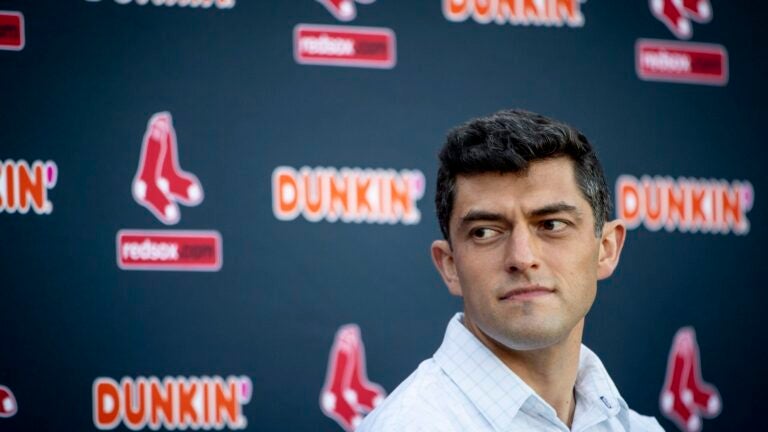The Red Sox are 1-5 since the deadline, watching the Rays pass them in the division while the Yankees and Blue Jays gain ground.
Red Sox Chief Baseball Officer Chaim Bloom could be looking back at this trade deadline as a missed opportunity. Maddie Malhotra/Boston Red Sox
The recently passed trading deadline might feel like the most frustrating in Red Sox history. The feeling is understandable as we sit here watching Anthony Rizzo seemingly launch a home run per day for the Yankees, but it’s not. I’ve got one worse, one that’s still annoying to think about 21 seasons later.
On July 31, 2000, the Red Sox trailed the Yankees by three games in the American League East. Neither team was extraordinary. The Yankees, winner of three of the previous four World Series, were 56-44. The Red Sox, starting to right themselves after going 9-18 in June, were 54-48, chasing the Yankees and 2.5 games back of the A’s for the lone wild card.
The Red Sox, as I suspect you were well aware at the time, hadn’t won a World Series since 1918. (I know, that championship drought seems so long ago now, right?). But it was the Yankees who spent the summer months improving their roster as if they were the franchise desperate to win, making three crucial deals in the weeks building up to the deadline.
On June 29, third-year general manager Brian Cashman traded pitchers Zack Day and Jake Westbrook to the Indians for outfielder David Justice, a postseason staple and frequent stalwart with the Braves and Indians. On July 12, or around the time Tom Brady was starting his Patriots career, Cashman sent Brady’s college teammate Drew Henson and a couple of other magic beans to the Reds for lefthanded pitcher Denny Neagle. And on July 21, he traded some roster filler to the Cubs for outfielder Glennallen Hill.
While Neagle was a flop (5.81 ERA), Justice and Hill combined for 36 home runs in 407 at-bats. Cashman fixed the Yankees on the fly, and there was pressure on Red Sox general manager Dan Duquette to make similar repairs to the Red Sox before the deadline.
Here is his full list of Red Sox moves over the last 10 days that July:
Signed third baseman Sean Berry, who played one game for the Red Sox, went 0 for 4, and was released.Released Mike Stanley, who signed with the A’s a few days later and put up an .827 OPS to help them win the American League West.Traded a package that amounted to Brian Rose, John “Way Back” Wasdin, and Jeff Frye to the Rockies for Rolando Arroyo and Mike Lansing, who would soon reveal themselves to be two of the most apathetic and unlikable players of that era.Signed utilityman Lou Merloni, who had recently been granted his request for release after hitting .213 for the Yokohama Bay Stars in the Japan Central League. Merloni proved the best of the pickups, hitting .320 in 40 games.
Oh, and a few days after the deadline, the Yankees added Jose Canseco on waivers from the Devil Rays, even though they didn’t have a place to play him. “I think I can play shortstop, and a little bit of third base,” Canseco joked at the time. ”I really don’t know how I’m going to fit in there.”
The Red Sox passed on claiming Canseco even though he might have helped. A few weeks later, they picked up another considerably less-fun DH-type, Dante Bichette, and didn’t even think to secure the future rights to his progeny.
The Yankees went on to capture their fourth World Series in five years despite winning just 87 regular-season games. The division was there for the taking, but the Red Sox didn’t do enough to take it – they finished with 84 wins, 2.5 games back in the AL East, and six behind the Mariners in the wild card.
So, yeah, that’s the most frustrating trading deadline, including the buildup, that I can recall in Red Sox lore. This most recent one, though – well, it has a shot at making the podium.
I’m a big believer in Red Sox Chief Baseball Officer Chaim Bloom. He seems to have a similar strength to each of the past four Red Sox general managers.
Like Dan Duquette, he knows how to find overlooked talent; Duquette’s Troy O’Learys and Tim Wakefields are his Hunter Renfroes and Garrett Whitlocks.
Like Theo Epstein, he has the desire and know-how to build a “player development machine,’’ and he also has a knack for finding genuine talent to aid the middle of the roster.
Like Ben Cherington, he’s adept at finding useful veterans in free agency and won’t be pressured into trading the highest-regarded prospects for a sudden fix. (Admit it: Some of you wanted to trade Xander Bogaerts for Cole Hamels back in the day.)
Like Dave Dombrowski, he knows how to win a trade, and hopefully, when the time comes, he will know which stars are worth paying for.
Bloom is already doing a terrific job here. Ownership got this hire right. But it’s also right to say that there’s a good chance he blew it at the deadline. Rizzo shouldn’t be fueling this Yankees surge; he should be with the Red Sox, the organization that drafted him. I find it hard to believe Bloom could not match the two-player package of Single-A prospects the Yankees sent the Cubs. Perhaps Kyle Schwarber will be the bat the Sox need. But they need something now, and Jose Canseco isn’t coming to the rescue.
Perhaps Chris Sale and to a lesser degree Tanner Houck can rescue the rotation. I’m never betting against Sale, whose mindset is perfect for this market. But Bloom should have acquired one more starting pitcher, especially given concerns about how Houck’s stuff will play when a lineup has seen him a couple of times. We should have been spared any more Garrett Richards starts weeks ago.
Entering Friday night’s game, the Sox were 1.5 back of the Rays in the division, and led the Yankees and Jays by just three games each in the loss column. They’ve lost five of six, gone 9-10 since the All-Star break, and it feels like it could get ugly against the Jays over the weekend. Martin Pérez is out of the rotation. Sale is coming back. Changes are happening. But patience is no virtue in this case: changes should have occurred a week ago, if not sooner, when every other relevant AL East team got better, and a Red Sox season that felt so good for so long took a sharp turn for the worse.
Get the latest Boston sports news
Receive updates on your favorite Boston teams, straight from our newsroom to your inbox.
Submit your email
Originally found on Read More



![[VIDEO] Meghan McCain Just Can’t Stop Blasting Biden Lately…](https://manateeherald.com/wp-content/uploads/2021/06/300-4IokkF.jpeg)




